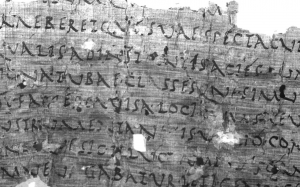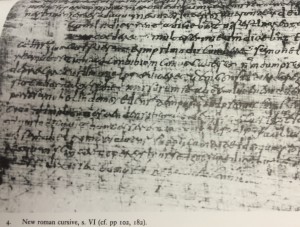How to write Rustic Capitals and Roman Cursive
Prior to viewing how the specific scripts are written, it is important to familiarize yourself with their history. Rustic capitals were used for copying and writing literary works. The individual letters in rustic capitals are easier to read than new and old roman cursive, however the script is written in scriptio continua, meaning there is no spacing between the words. The cursive forms were used mainly in every day life situations such as shops and letters. Old roman cursive was a popular script between the 1st century BCE to the third century CE. It can be found mostly on wax tablets, graffiti, and other various inscriptions. The new roman cursive was popular between the 3rd and 10th century.
For more historical background on these different types of scripts, please follow the link below!
In my tutorial, I did not use a reed pen because I thought it was easier to see using this writing utensil. A reed pen is encouraged when writing in these scripts. Below, you will see images in all three of these different scripts. Notice the variance as well as the similarities between them and how script evolved through the centuries!
Rustic Capital Example #1

This example from a manuscript of Virgil's Aeneid highlights a few points I made within the tutorial video. First, it is evident how the 'M' looks like two 'A's put together. This script also demonstrates the 'A' without the middle cross bar. Lastly, I feel this example demonstrates some of the difficulty of deciphering certain letters from one another. In the third line, the 'L', 'I', and 'T' all look very similar and can often be mistaken for one another.
Rustic Capital Example #2

Within this example of the De Bello Actiaco, it is possible to spot the 'A' with the middle cross bar which I discussed within the tutorial.
Rustic Capital Example #3

Old Roman Cursive Example #1

New Roman Cursive Example #1

New Roman Cursive Example #2

The beginning lines within this letter read:
"cum in omnibus bonis benignitas tua sit praedita tum etiam scholasticos maxime qui me cultore tuo hono"
Thank you for visiting my page and taking the time to read my post regarding Rustic Capitals as well as Old and New Roman Cursive. I hope you have found this information to further your understanding of these scripts. I encourage you to browse the other posts on this website for further reading regarding a wide variety of interesting and informative topics.
Sources
Bischoff, Bernhard. Latin Palaeography: Antiquity and the Middle Ages. Cambridge: Cambridge UP, 1990. Print.
http://medievalwriting.50megs.com/scripts/examples/newroman.htm#picture
http://www.cispe.org/en/immagini/
http://www.britannica.com/art/calligraphy/images-videos/Rustic-capitals-from-a-manuscript-of-Virgils-Aeneid-4th-century/110974
This explanation (with samples and video) was fascinating and informative. Thank you!